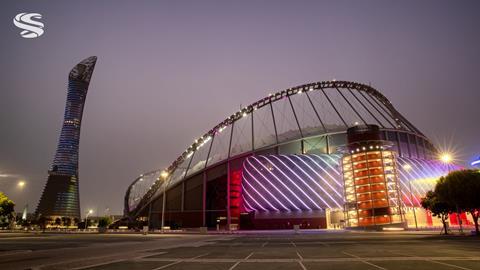Jim Salveson, director of sport at Sport Social Podcast Network, takes a look at how to approach audio during the Qatar 2022 World Cup

Before the World Cup kicked off, Gianni Infantino claimed that this winter’s festival of football would be watched by five billion people. Of course, there is no denying the global appeal of the world cup and the audience it demands. Whilst TV audiences are well established, it’s the audio market that is booming and offering creators and brands new routes to connect with worldwide football fans.
Podcast listening has skyrocketed over the last few years and there is no sign of this slowing down. In 2021 alone there were 383 million podcast listeners, and this is well on track to reach a forecasted 424 million listeners by the end of 2022. Sports podcasts make up 20% of the overall podcast market, with football being the most popular, drawing in a total of 40% of these sport fans. That’s an estimated crowd of 34m people listening to football podcasts regularly. Of course, a large portion of those are hungry for World Cup content.
Given podcast audio is now so accessible, it won’t be long before this tournaments’ audio audience is measured in billions – so what opportunity does this provide brands, rights holders and media providers both now and in the future?
The golden rule of advertising is ‘meet audiences where they are’, and for this World Cup, more than any other we’ve seen, those audiences are online. According to Nielsen Fan Insights, 80% of sports fans (which is 89% if you boil it down to football) regularly consume sport content via online channels, whether that is social media, live streamed matches or, increasingly, on-demand audio such as podcasts. Football fans are calling out for sports audio content and rights holders have an open goal to deliver this, if you pardon the pun.
With audiences consuming content via more diverse channels, it is now vital that brands reach those audiences through an equally diverse mix of media to reach passionate sports fans. There’s no denying that audio and sport have always gone hand in hand. It’s a carrier of identification and affiliation. From singing the national anthem to the creative chants of stadium crowds, to excitable commentators and the passion of a radio fan phone-in. The audio experience is ingrained into our consumption of sports, especially football. With podcast audiences, we are seeing a fanbase whose passion for the game is only matched by their passion for the medium.
According to Edison’s 2021 Super Listener Survey, audiences who engage with large quantities of audio (over 10 hours a week) not only say they pay more attention to podcast advertising than other mediums (51% agree), but also say that their opinion of a company is more positive when they sponsor or advertise on a podcast that they regularly listen to (53% agree).
This relationship between podcast and audience allows brands and advertisers to engage in conversations in a way that other mediums cannot offer. With the controversy surrounding a tournament such as the World Cup in Qatar, this provides the opportunity to be involved in genuine fan discussions that official partners cannot and build authentic connections with audiences, especially if they can sponsor ’positive content’.
These opportunities are not unique to this winter’s World Cup either. Major sporting events of any kind lead to increased engagement and audience spikes. Combine that with an already booming podcast market and it becomes a medium that rights holders, brands and advertisers can no longer ignore. Many are now putting audio in the ‘must have’ instead of ‘nice to have’ box, showing how audio really is a secret fan engagement weapon just waiting to be unleashed.

Jim Salveson is director of sport at Sport Social Podcast Network




No comments yet